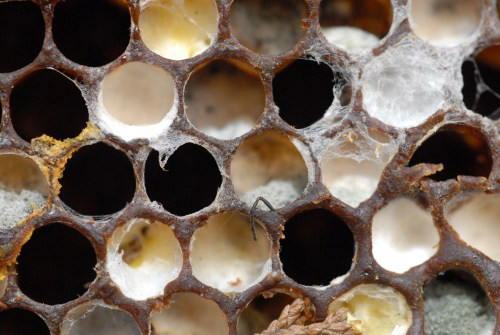Honeybee Diseases - Stonebrood
Stonebrood disease - is caused by a fungus and is considered of minor importance, but should not be totally ignored by bee inspectors and beekeepers. It is rarely encountered, but should be differentiated from the other more serious brood diseases. Several fungi belong to the genus Aspergillus can cause the symptoms of stonebrood although the primary causative organism is Aspergillus flavus. It is not regarded as a serious disease in normal circumstances, its effects on the colony being only slight. It is generally present in the majority of colonies at some point in time and can be present in its spore stage without affecting the colony.
Download the Stonebrood Info Sheet to obtain a printable version of Dysentery information, detection and treatment methods for your records.
Recognition
Image Courtesy Windowbee.com ©

Larvae mummified by stonebrood, look very similar to chalkbrood, but turn green and hard.
As in chalkbrood, stonebrood disease causes a mummification of brood. Larvae and pupae that are infected with Aspergillus flavus turn green in contrast to white or black in chalkbrood. The green growth is powdery and can be readily seen with the naked eye. Fungus spores are found most abundantly near the head of affected larvae and pupae. Stonebrood diseased larvae are solid mummies and not sponge-like as in chalkbrood.
Detection
Hive Examination - Examination of brood frames and floor debris is required especially in spring. Bees should be gently shaken from the frames to allow full inspection, abnormalities are then easily spotted. Stonebrood 'mummies' are easily seen and may even fall out of the cells during examination.
Monitoring - Vigilance is important with all honeybee diseases. Check all apiaries and colonies regularly for health and suspect any colonies that are not thriving where there is no already known reason. Colonies that are not performing well or die out should be examined thoroughly and sealed to prevent robbing and spread of any diseases present.
Treatment
Presently there is no effective medical treatments for Stonebrood, and there is no specific treatment recommended for Stonebrood. The disease has only slight effect on healthy colonies but may have a more serious effect on weakened colonies. Prevention is the best method of controlling this disease by maintaining healthy, strong and vigorous colonies that display good hygienic traits. Good husbandry contributes greatly to overall colony behaviour and health, thereby avoiding the conditions in which stonebrood can flourish. Colonies that suffer excessively from Stonebrood may need to be re-queened. Prevention is best practice, maintain good apiary housekeeping and bee husbandry:
- Always maintain strong and vigorous colonies that show good hygienic tendencies, re-queen from known healthy colonies.
- Always maintain a high level of hygiene in all your beekeeping practices
- Carry out methodical health inspections on a regular basis, checking for brood disease particularly in spring and autumn.
- Never transfer combs between colonies without checking for brood diseases
- Systematically replace old brood combs in your hives melting down the old comb to maintain clean and healthy brood.
- Never bring colonies or equipment into your apiary without establishing their origin, condition, and disease status.
- Sterilise any secondhand equipment or hive components before introducing them into your apiary
- Discourage drifting and robbing in the apiary
- Suspect stray swarm health until you know otherwise
- Report any incidence of disease or suspicious conditions immediately to your local association
Vectors
As with many honeybee related diseases, the beekeeper is the main vector in the spread of this disease by transferring, selling or exchanging frames and combs, honey or equipment which is infected. Robbing of infected and depleted hives and swarms from infected colonies also transmit the disease.
- Beekeepers - Transferring contaminated equipment / material between hives, colonies and apiary sites.
- Robbing - Colonies weakened by other ailments will fall prey to robbing, transferring spores to other colonies and apiaries.
- Drifting - As with Robbing will transfer spores to other colonies.
- Swarming - Swarms can carry the spores with them to new sites where the disease will spread once new brood is produced.
Try the Honeybee Diseases Quiz
About the 'My Beekeeping Kit' website.
Contact Iain Dewar for enquiries, suggestions, corrections and contributions for improving the notes. Always welcome!